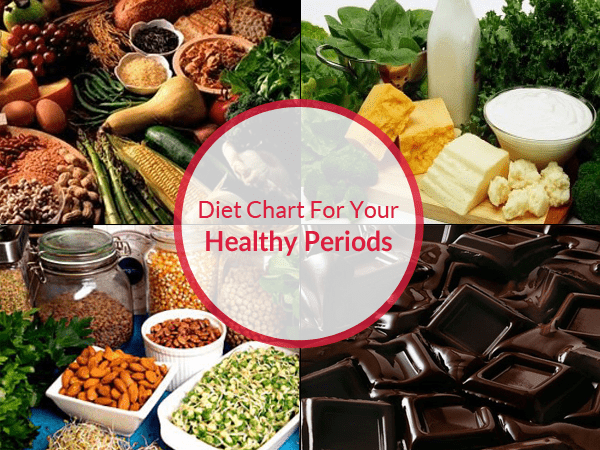
Menstruation is an integral phenomenon of a female’s health and a good parameter for her evaluating her physical well-being. Just imagine if we can track our hormonal levels at specific times during a month and get a clear idea of how we can use it to our benefit!! Wouldn’t that be great? Here is a diet chart that shall help you plan your life more systematically around your periods. I have also added food products that shall help you overcome the effects of these hormones on our general well being. This guide is divided into 4 weeks (monthly menstrual cycle), each having its own function & foods that will help us elevate our productivity.
WEEK 1 (DAY 1- 7)
Week 1 begins with the start of your menstrual cycle. Estrogen levels are high during this week. Higher estrogen levels will boost your energy, mood, optimism and mind. In this week, you feel like spending time with people you like the most they may be your friends or family. During this week you are more curious about the world, want to have fun, enjoy shopping and prefer to be out of the house and among others.
Diet Chart During Periods
√ Foods To Have :
1. Complex Carbohydrates Fruits, vegetables and whole foods are your friends always, but especially during menstruation. The fruit from sugar may help alleviate sugar cravings. Try adding apricots, oranges, plums, pears, cucumbers, corn and carrots to your diet.
2. Magnesium Rich Foods Foods rich in magnesium like beans, tofu and peanuts are thought to reduce bloating in menstruating women.
3. Calcium Rich Foods In studies of college-aged women and nurses, women with the high intake of Calcium and Vitamin D were less likely to develop PMS. The RDA (Recommended Dietary Allowance) of Calcium for women is 600 mg/day, to get these amounts, aim for at least three servings of calcium-rich foods a day, such as low-fat milk, cheese, yogurt, leafy vegetables. It’s difficult to get enough vitamin D from diet alone (salmon and fortified milk are good sources), but women can make up the difference with a daily multivitamin or a supplement. Many calcium supplements also contain vitamin D.
4. Indulge In Dark Chocolate Having a piece of dark chocolate (with 60 percent or higher cacao bean) every day during your period will help soothe cravings. Plus, dark chocolate has helpful antioxidants and is linked to boosting serotonin, which can help improve your mood.
× Foods to Avoid
1. Caffeine Cutting back on caffeine intake can help reduce bloating and calm an irritable stomach. “Caffeine can increase stomach acid and be rough on sensitive intestines. If you want a rich-tasting coffee substitute, try a cup of tea.
2. Don’t Skip The Water Drinking more water will help your body release water retention and alleviate bloating. “Your body is retaining water because it’s afraid of not getting enough. So, if you give it what it needs (more water) it will release the water it’s holding onto.”
3. Too Much Salt Though salt is crucial to good health, boating and water retention can occur if you overdo it. The best way to control salt intake is to avoid processed and fast foods, many of which contain three to four times the salt you should have in one meal.WEEK 2 (DAY 8-14)
Estrogen and testosterone levels are high till their peak. During this stage you are more optimistic and confident. Your memory becomes sharper and you start thinking faster also you are more concern about your appearance.
WEEK 3 (DAY 15-22)
Progesterone levels are high compare to Estrogen and testosterone. After half of the week again estrogen level raises. The first half of the week 3 is the “pre-PMS” phase. This phase you will feel more sleepy, quiet, less interested in social. You are getting more craving of foods like sugar, fat and salt. You will like hungry and this tends to over eating. Avoid foods rich in fats, oil, sugar & salt to maintain your body and don’t over eat. Have lots of green vegetables, fruits, pulses chaat (chana chaat, sprouts chaat), dry bhel, a piece of rajgira chikki to overcome from your food craving and stay healthy.
WEEK 4 – (Final 6 days of your cycle)
Estrogen level are still low at this level which leads to moodiness, muscle ache, fatigue and a variety of other PMS related symptoms. Symptoms may differ in the type and intensity of each individual and even from month to month. This often happens due to changes in the diet, stress, medication, habit etc. This is the natural rest and restoration phase of the cycle, and if you don’t rest you can experience less energy in the following phases. Try to change your activities to only doing the highest priorities. Don’t try to maintain your usual meal routines, follow what your body wants. Take time to eat slowly and savor your food. Avoid using caffeine to see through this phase. You may naturally wish to eat less or choose simpler foods, as your digestion takes a rest.
Have question regarding Diet and Nutrition? Ask our Expert, Khyati Rupani, here.







,